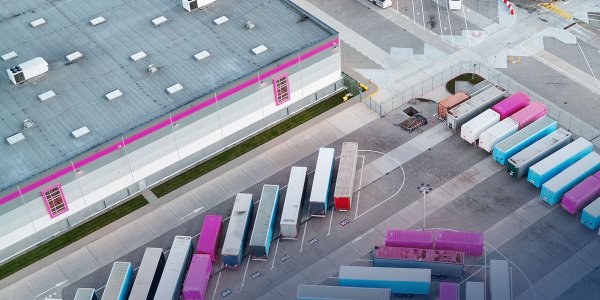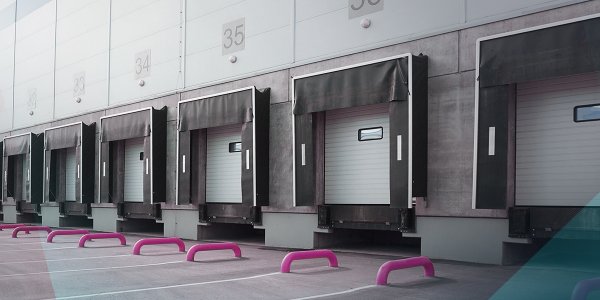The yard is at the center of many logistics processes along the supply chain. This creates two overarching challenges for yard management, which have a strong influence on a shipper's planning: Inbound and outbound logistics. The necessary overview is provided by digital collaboration platforms that enable simple communication between the numerous parties in the supply chain.
For myleo / dsc, the focus is on the yard as the heart of many logistics processes. From this perspective, the supply chain is divided into three overarching components: Next to the yard are the inbound and outbound logistics. In order to explain how myleo / dsc as a holistic platform simplifies the management of all sub-areas, we must first discuss the differences between inbound and outbound.
Dock & Yard Management: Yard at the Heart
The yard is a central location in the logistics chain that serves as an interface between inbound and outbound logistics. It is an area where goods are received, temporarily stored, sorted or prepared for further transportation. Yard management plays a crucial role in ensuring that logistics processes run smoothly. Procurement is organized from here, e.g. trucks are unloaded, goods are sorted onto pallets and prepared for dispatch.
Inbound vs. Outbound - Fundamental Difference
Inbound logistics comes before yard logistics in the overall process: it refers to the movement of goods from suppliers to a warehouse or production site, e.g. from a car manufacturer. This includes various activities such as the transportation, unloading, inspection and storage of incoming products. The aim of inbound logistics is to ensure that the required materials reach the manufacturer's logistics yard on time and in the right quantity. Appointment scheduling in particular is therefore an important process in inbound management. In addition, the manufacturer should provide sufficient employees, warehouse resources and truck parking spaces to receive the goods.
Meanwhile, outbound logistics is about the process of moving goods from the warehouse or production site to a customer or distribution center. This includes tasks such as picking, packing, shipping and transportation management of the respective products. The core objective of outbound logistics for the shipper, in this case the car manufacturer, is to deliver or provide the products on time and in good condition.
On closer inspection, both inbound and outbound logistics can be divided into four central levels that determine the overall process.
Four Layers of Inbound Logistics
Inbound logistics starts with the procurement of goods and only ends when they are unloaded at the yard. The individual processes can be clearly divided into four levels:
Level 1: Integration
The integration layer is the basis of inbound logistics. This includes orders, scheduling agreements and contracts.
Level 2: Cooperation
Cooperation between the logistics partners begins at this level. Together with the manufacturer, the supplier determines the quantity of goods and the delivery time and then sends the notification.
Level 3: Transparency
The "transparency" level is based on communication between the supplier and shipper. In addition to the transmission of goods and vehicle information (type, quantity, etc.), this also includes short-term notifications about changes to the delivery window due to traffic jams or traffic accidents.
Level 4: Dock & Yard Management
Dock & yard management includes processes such as registration, check-in and check-out, routing, handling and many small ancillary processes. With yard management software, many of these processes can be digitalized and even automated so that the shipper has as little manual effort as possible.

Four Layers of Outbound Logistics
Outbound logistics is structured in a similar way. Although there are other processes here, these can also be assigned to the four levels of "integration, collaboration, transparency and dock & yard management":
Level 1: Integration
The integration of the shipper begins with the delivery or transportation of the goods.
Level 2: Collaboration
Cooperation in outbound consists of the transportation order by the customer and appointment scheduling with a carrier as well as capacity planning, as in inbound.
Level 3: Transparency
To ensure the necessary transparency in outbound logistics, it is up to the shipper to keep an eye on the supply control: When will the truck arrive to collect the goods to be made available? The proof of delivery is proof of a successfully completed delivery. The process is only complete when the transport vehicle has reached its destination at the specified time or any delays have been communicated in advance.
Level 4: Dock & Yard Management
The dock & yard management processes are the same as for inbound logistics. The only difference is that the shipper is now in the role of the supplier.
Problems in Inbound and Outbound
In most cases, problems in the supply chain start with transparency: suppliers and shippers often perceive the tasks at the transparency level as unimportant ancillary steps that are unnecessary and simply waste capacity. Processes such as notification, appointment scheduling or track-and-trace in inbound, as well as the supply control and tracking (RTTV) in outbound often form a black box: Suddenly a truck is standing in front of the logistics yard - and nobody really knows whether the order is even complete or whether other trucks are on their way. It is also unclear how many or which goods in the order are actually in the transport vehicle.
The same applies to outbound deliveries. This results in many unanswered questions: How much space is required for storage? Are the goods complete? Will there be more trucks that need to be accommodated on the yard? How many employees should be on site and when? When will the delivery finally reach the end customer? And why has the delivery time been exceeded? Whether inbound or outbound - without the necessary transparency, all parties involved are at worst left in the dark. This results in uneconomical expenses that not only cost time but also money, for example because the truck has to be turned away or there is no storage space for the next delivery. Employees are also annoyed sooner or later if they are constantly driving to work for nothing due to missing deliveries.
Everything Needs to Work Together
In summary, inbound logistics controls the flow of materials to a warehouse or production site, while outbound logistics organizes the flow of goods from the warehouse to customers or distribution centers. The yard forms a central hub where the transitions between inbound and outbound are coordinated in order to maximize the efficiency of the entire logistics chain. In order for these processes to interlock without causing friction, all logistics partners must always be on the same page. However, this task cannot be accomplished manually due to the large amount of information involved. The consequences are careless errors or forgotten reports of delays. A solution to this problem is offered by integrated platforms that connect all parties.
The Solution: Collaborative Platforms
Yard management solutions are designed to simplify all processes in the logistics yard. They have helpful functions such as check-in and check-out for delivery drivers and automated call-offs for free loading points or gates. Additional communication options, such as integrated chat functions, help logistics partners to stay informed at all times. As a specialized all-in-one solution, myleo / dsc goes one step further and offers a holistic platform for all supply, yard and transport processes. In addition to numerous interfaces to common systems and devices, digital notifications are also supported. At the same time, deliveries can be tracked in real time - the status quo is clearly visualized for the control station. In this way, the platform creates transparency throughout the entire supply chain, which the shipper can use as a basis for planning.
Do you want reliability for your inbound and outbound processes? You can find more information about myleo / dsc at: https://myleodsc.com/de/yard-management

